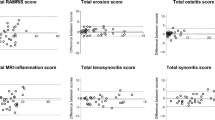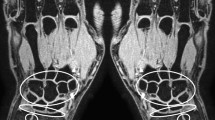Abstract
The goal of this study was to compare magnetic resonance (MR) image quality at different field strengths for evaluating lesions in wrist and finger joints of patients with rheumatoid arthritis (RA) in order to determine whether the higher field strength provides diagnostic gain. The hand mainly affected in 17 RA patients was examined at 1.5 Tesla (T) and 3.0 T with comparable MR imaging (MRI) protocols. MR images were reviewed twice by two experienced radiologists using the Rheumatoid Arthritis MRI Scoring System (RAMRIS) of the OMERACT (Outcome Measures in Rheumatoid Arthritis Clinical Trials) group. Image quality was rated on a five-point scale using Friedmann’s test and Kendall’s W-test for statistical analysis. Image comparison revealed better image quality at higher field strength. Image quality of T1-weighted images was rated 14–22% better at 3.0 T compared with 1.5 T by both readers. Moreover, the rating for the T2-weighted-images acquired at 3.0 T was one point better in the five-point scale used. Inter-reader correlation for image quality, bone erosions/defects, edema and synovitis ranged between 0.6 and 0.9 at 3.0 T and between 0.6 and 0.8 at 1.5 T. Intra-reader correlation for these parameters was high at 0.8–1.0. MRI image quality of RA hands is superior at 3.0 T, while an acceptable image quality is achieved at 1.5 T, which improves the evaluation of extent of bone edema, synovitis and identification of small bone erosions.



Similar content being viewed by others
References
Zink A, Huscher D, Thiele K, Listing J, Schneider M (2004) National database of German arthritis centers. Tool for health services research. Bundesgesund-heitsblatt Gesundheitsforschung Gesundheitsschutz 47(6):526–532
Emery P, Seto Y (2003) Role of biologics in early arthritis. Clin Exp Rheumatol 21(5, Suppl 31):S191–S194
Scott et al (1986) Long term progression of joint damage in rheumatoid arthritis. Ann Rheum Dis 45:373–378
Backhaus M, Kamradt T, Sandrock D, Loreck D, Fritz J, Wolf KJ, Raber H, Hamm B, Burmester GR, Bollow M (1999) Arthritis of the finger joints: a comprehensive approach comparing conventional radiography, scintigraphy, ultrasound, and contrast-enhanced magnetic resonance imaging. Arthritis Rheum 42:1232–1245
Sugimoto H, Takeda A, Masuyama J, Furuse M (1996) Early-stage rheumatoid arthritis: diagnostic accuracy of MR imaging. Radiology 198:185–192
McQueen FM (2000) Magnetic resonance imaging in early inflammatory arthritis: what is its role? Rheumatology 39:700–706
Sugimoto H, Takeda A, Hyodoh K (2000) Early-stage rheumatoid arthritis: prospective study of the effectiveness of MR imaging for diagnosis. Radiology 216:569–575
Peterfy CG (2001) Magnetic resonance imaging in rheumatoid arthritis: current status and future directions. J Rheumatol 28:1134–1142
Klauser A, Demharter J, De Marchi A, Sureda D, Barile A, Masciocchi C, Faletti C, Schirmer M, Kleffel T, Bohndorf K (2005) Contrast enhanced gray-scale sonography in assessment of joint vascularity in rheumatoid arthritis: results from the IACUS study group. Eur Radiol 15(12):2404–2410
Ostergaard M, Peterfy C, Conaghan P, McQueen F, Bird P, Ejberg B et al (2003) OMERACT Rheumatoid arthritis magnetic resonance imaging studies: core set of MRI acquisitions, joint pathology definitions, and the OMERACT RA-MRI Scoring System. J Rheumatol 30:1385–1386
Peterfy C, Edmonds J, Lassere M, Conaghan P, Ostergaard M, McQueen F, Genant H, Klarlund M, Ejbjerg B, Stewart N, Bird P, Shnier R, O’Connor P, Emery P (2003) OMERACT rheumatoid arthritis MRI studies module. J Rheumatol 30:1364–1365
Lassere M, McQueen F, Ostergaard M, Conaghan P, Shnier R, Peterfy C, Klarlund M, Bird P, O’Connor P, Stewart N, Emery P, Genant H, Edmonds J (2003) OMERACT rheumatoid arthritis magnetic resonance imaging studies. Exercise 3: an international multicenter reliability study using the RA-MRI score. J Rheumatol 30:1366–1375
Kainberger F, Peloschek P, Friedrich K, Pinker K, Redlich K, Schett G (2002) Magnetresonanztomographie (MRT) zur Frühdiagnostik und Verlaufskontrolle bei Rheumatoider Arthritis. Aktuel Rheumatol 27:311–316
Bruhn H, Gyngell ML, Hänicke W, Merboldt KD, Frahm J (1991) High-resolution fast low-angle shot magnetic resonance imaging of the normal hand. Skelet Radiol 20:259–265
Elster AD (1997) How much contrast is enough? Dependence of enhancement on field strength and MR pulse sequence. Eur Radiol 7:276–280
Gold GE, Han E, Stainsby J, Wright J, Brittain J, Beaulieu C (2004) Musculoskeletal MRI at 3.0 T: relaxation times and image contrast. AJR Am J Roentgenol 183:343–351
Constable RT, Gore JC (1992) The loss of small objects in variable TE imaging: implications for FSE, RARE, and EPI. Magn Reson Med 28:9–24
Schröder RJ, Fischbach F, Unterhauser FN, Weiler A, Felix R, Bruhn H (2004) Value of various MR sequences using 1.5 and 3.0 Tesla in analyzing cartilaginous defects of the patella in an animal model. Fortschr Röntgenstr 176:1667–1675
Ostendorf B, Scherer A, Mödder U, Schneider M (2004) Diagnostic value of the forefeet in early rheumatoid arthritis when findings on imaging of the metacarpophalangeal joints of the hands remain normal. Arthritis Rheum 50:2094–2102
Savnik A, Malmskow H, Thomsen HS, Graff LB, Nielsen H, Danneskjold-Sansoe B et al (2002) MRI of the wrist and finger joints in inflammatory joint diseases at 1-year interval: MRI features to predict bone erosions. Eur Radiol 12:1203–1210
Lenk S, Ludescher B, Martirosan P, Schick F, Claussen C, Schlemmer H (2004) 3.0 T high-resolution MR imaging of carpal ligaments and TFCC. Fortschr Röntgenstr 176:664–667
Bachmann R, Reilmann R, Schwindt W, Kugel H, Heindel W, Kramer S (2006) FLAIR imaging for multiple sclerosis: a comparative MR study at 1.5 and 3.0 Tesla. Eur Radiol 16(4):915–921
Author information
Authors and Affiliations
Corresponding author
Rights and permissions
About this article
Cite this article
Wieners, G., Detert, J., Streitparth, F. et al. High-resolution MRI of the wrist and finger joints in patients with rheumatoid arthritis: comparison of 1.5 Tesla and 3.0 Tesla. Eur Radiol 17, 2176–2182 (2007). https://doi.org/10.1007/s00330-006-0539-0
Received:
Revised:
Accepted:
Published:
Issue Date:
DOI: https://doi.org/10.1007/s00330-006-0539-0




